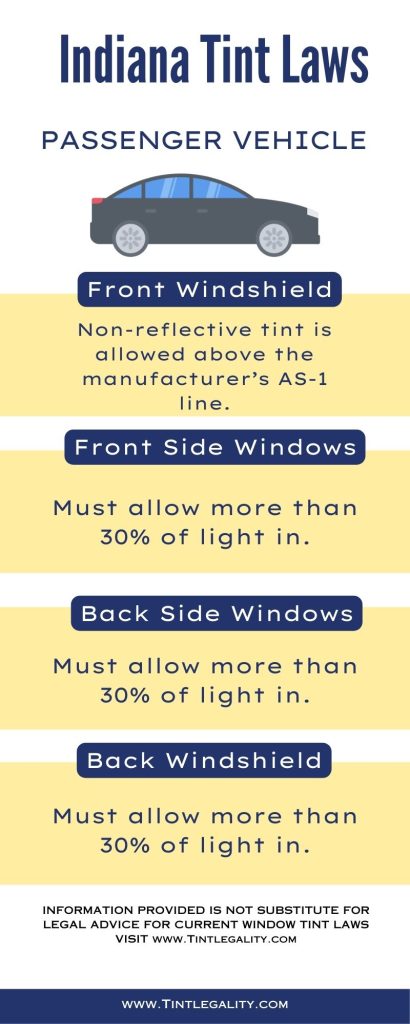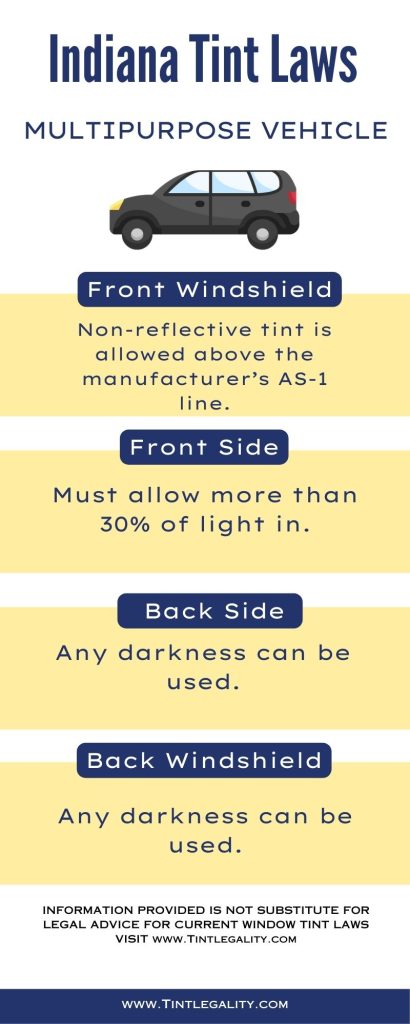Indiana tint laws were enacted in 2003, establishing guidelines for the percentage of visible light that can pass through different windows of a vehicle.
These laws are designed to ensure that drivers have adequate visibility and that law enforcement officers can easily see into the vehicle when necessary.
Regulations Regarding Window Tint in Indiana
| Window Type | Legal Tint Limit |
|---|---|
| Windshield | Top 6 inches or as specified by the manufacturer |
| Front Side Windows | At least 30% VLT |
| Back Side Windows | No minimum VLT |
| Rear Window | At least 30% VLT |
Windshield
The windshield of a car can be tinted, but only along the top six inches or as specified by the manufacturer.
The tint must not be more than 35% reflective, and the visible light transmission (VLT) percentage cannot be less than 30%.
Front Side Windows
The front side windows of a car (the windows on either side of the driver) must allow at least 30% of visible light to pass through.
This means that the tint cannot be too dark, as it would reduce visibility for the driver.
Back Side Windows
The back side windows (behind the driver) can be tinted as dark as desired, as long as the VLT percentage is greater than 30%.
However, if the vehicle has side mirrors, the back side windows can be tinted darker than 30%.
Rear Window
The rear window of a car can also be tinted as dark as desired, but the VLT percentage cannot be less than 30%. Again, if the vehicle has side mirrors, the tint can be darker than 30%.


Additional Regulations
In addition to the guidelines listed above, there are a few other regulations that drivers should be aware of when it comes to window tint in Indiana.
Reflection
The tint on any window of a car cannot be more than 25% reflective. This is to ensure that the driver’s view is not obstructed by reflections from the tint.
Medical Exemptions
If a driver has a medical condition that requires them to be shielded from the sun, they may be able to obtain a medical exemption for their tint.
However, they must provide documentation from a licensed physician stating that the tint is necessary for their health.
Color Restrictions
In Indiana, the only color of tint that is legal for front side windows is clear or colorless.
This means that drivers cannot have a tint that is red, blue, or any other color.
Side Mirrors
If a car has tinted back-side windows or a tinted rear window, it must also have side mirrors that provide a view behind the vehicle.
This is to ensure that the driver has adequate visibility when backing up or changing lanes.
Exceptions to Legal Limits
There are a few exceptions to the legal limits for window tint in Indiana. These include:
- Vehicles that were manufactured with tinted windows before the Indiana tint laws went into effect in 2003. However, the tint cannot be darker than what was originally installed by the manufacturer.
- Vehicles that are registered in another state, as long as they meet the tinting requirements for that state.
- Law enforcement vehicles, which may have tinted windows to protect officers.
Penalties for Breaking the Law
If a driver is caught with illegal window tint in Indiana, they may face fines and other penalties. The severity of the penalties depends on the number of previous convictions.
Fines
The first offense for illegal tint can result in a fine of up to $150. Subsequent offenses
Second Conviction
If a driver is caught with illegal tint a second time, they may face a fine of up to $250.
Third Conviction
A third offense for illegal tint can result in a fine of up to $500.
Other Penalties
In addition to fines, drivers may also be required to remove the illegal tint from their vehicle and have it re-inspected.
If the tint is not removed within a certain time frame, the driver may face additional fines or even have their vehicle impounded.
Penalties for Non-Compliance
It’s important to note that if a driver is involved in an accident and found to be non-compliant with Indiana tint laws, their insurance may not cover the damages.
This can result in significant out-of-pocket expenses for the driver.
Can you get pulled over for tint in Indiana?
Yes, you can get pulled over for illegal tint in Indiana.
Is 20% tint legal in Indiana?
No, 20% tint is not legal for front side windows in Indiana.
What is the darkest legal tint in Indiana?
The darkest legal tint in Indiana depends on the type of window.
How dark is 50 tint?
50% tint allows 50% of visible light to pass through.
Is 70 tint worth it?
70% tint may not provide significant benefits and is not common for cars.
References:
https://en.wikipedia.org/wiki/Indiana
https://iga.in.gov/legislative/laws/2017/ic/titles/009#9-19-19